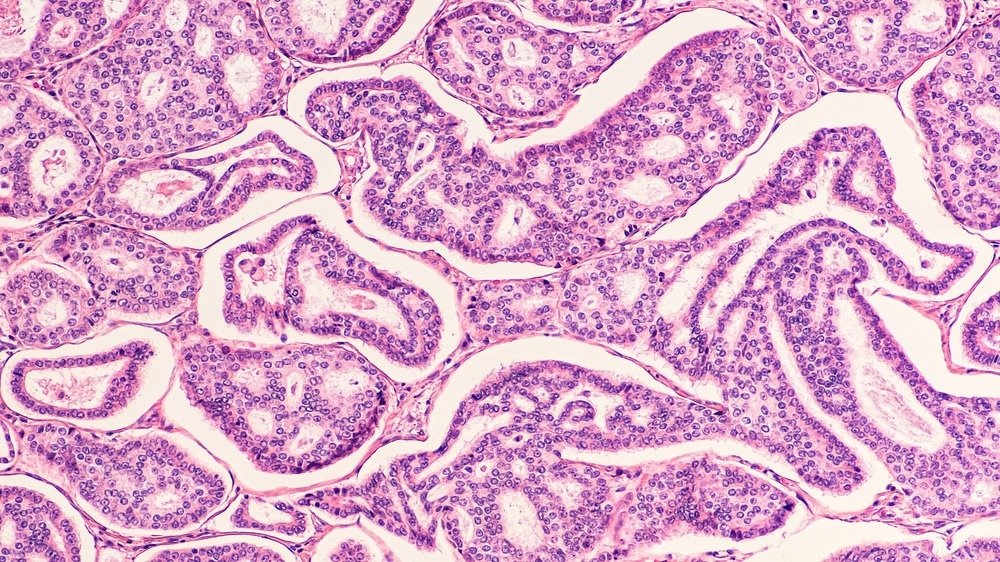Anastrozole (ANS) anticancer therapy needs long-term administration until tumor regression is achieved. In an article recently published in the journal Materials Today, researchers explored anastrozole-loaded silk fibroin nanoparticles as promising candidates for sustained drug delivery in breast cancer treatment.

Study: Silk fibroin-anastrozole loaded prolonged-release biodegradable nanomedicine: A promising drug delivery system for breast cancer therapy. Image Credit: David A Litman/Shutterstock.com
Nanomaterials in Breast Cancer Treatment
ANS is a nonsteroidal aromatase inhibitor used to treat advanced or last-stage breast cancer in women at the postmenopausal stage. ANS adheres to the aromatase enzyme and reversibly suppresses its activity. However, the ANS-based cancer treatment requires continuous administration of the drug until tumor regression is achieved. To fill this gap, the frequency of drug administration can be reduced through sustained delivery treatments while maintaining constant plasma concentration. Moreover, sustained delivery treatments can reduce the side effects, increase patient compliance, and decrease third-party payer’s costs.
Previous reports explored various multifunctional and sophisticated nanocarrier systems for target-specific transport of pharmaceuticals in a sustained and regulated manner, thus generating safer and more effective treatments. Polylactide-co-glycolide acid-based synthetic polymer (PLGA) nanoparticles are used in the sustained nanoparticulate drug delivery industry. However, the PLGA drug delivery systems cause drug instability and safety issues.
ANS-loaded SF Nanoparticles
In the present study, the researchers fabricated ANS-incorporated SF nanoparticles for breast cancer therapy. They employed a solvent change method with varying concentrations of silk fibroin to formulate the nanoparticles.
The as-prepared nanoparticles were characterized for their particle size, polydispersity, zeta potential, and encapsulation efficiency (%EE). Furthermore, variance analysis (ANOVA) helped in selecting the optimized formulation, followed by thermal analysis, surface morphology, compatibility studies, transmission electron spectroscopy (TEM), x-ray diffraction (XRD), accelerated stability study, and drug release profile.
Research Findings
The reduction of mannitol and SF concentration were confirmed from the three-dimensional (3D) plot and regression data obtained from ANOVA analysis. The 3D surface graph and regression data revealed a radical increase in %EE, wherein increasing amplitude and sonication time enhanced %EE.
A set of 16 batches of ANS nanoparticles were characterized using dynamic light scattering (DLS), and the size range was between 11 ± 1.2 to 442 ± 1.1 nanometers. Similarly, the polydispersity index (PDI) was in the range of 0.10 ± 01 to 0.80 ± 06, representing uniform size and distribution.
The zeta potential for ANS-nanoparticles was between 0.88 ± 3.13 and 24 ± 3.44 millivolts, indicating their neutral charge and the distribution potential in the physiological pH medium.
The Fourier transform infrared spectroscopy (FTIR) of ANS displayed strong peaks for carbon-oxygen (C-O), medium alkyl (C-H), carboxyl (O=C=O), and weak amine (C-N) stretching absorption peaks at 1138, 3102, 2363, and 2236-centimeter inverse, respectively. The high-resolution TEM revealed that SF-ANS nanoparticles were spherical and octahedral in shape and were distributed as distinct particles.
Differential scanning calorimetry (DSC) analysis of ANS, SF, mannitol, and SF-ANS nanoparticles revealed that pure ANS showed a sharp endothermic peak at 88.94 degrees celsius, corresponding to its melting point, which also confirmed its crystalline structure.
Powder XRD analysis of SF-ANS nanoparticles was compared to pure ANS, and the results revealed a change in diffraction peaks. Additional peaks were formed in the diffractogram of SF-ANS nanoparticles. The low-intensity peaks in the PXRD diffractogram were due to the crystalline structure of SF-ANS nanoparticles. The relative intensity of the 2θ value for SF-ANS nanoparticles was different when compared to pure ANS and silk fibroin.
Field emission scanning electron microscope (FE-SEM) images of SF-ANS nanoparticles showed the smooth surface of the nanoparticles with uniform size distribution in the longitudinal crystal structure. The nanoparticles were oriented within close proximity with restrictions in size distribution. Further, the FE-SEM image showed the interactions between drug and polymer that resulted in the formation of matrix structures. From the above findings, the researchers inferred that the drug molecules were uniformly distributed in polymeric structures which resulted in the formation of nanoparticles.
The release profile of optimized SF-ANS nanoparticles demonstrated that more than 94.15% of the drug was released in 168 hours. On the first day, a burst release phase was followed by a steady release phase. The aqueous dissolution medium diffused into the matrix, followed by drug diffusion into the medium through the pores.
Conclusion
In conclusion, the researchers used a solvent change technique to develop SF-based ANS nanoparticles. The formulated biodegradable nanoparticles demonstrated a sustained-drug releasing capacity.
DSC and morphological analysis revealed that ANS was distributed evenly in the crystalline or amorphous state in the polymer matrix. At the 168th hour, 94.15% of ANS was released and exhibited anticipated stability for three months.
The biocompatibility, narrow size range, and biodegradability enabled the fabricated nanoparticles to be promising candidates for parenteral applications. The SF-based ANS nanoparticles are suitable drug delivery systems for long-term treatments.
Reference
Nasrine, A., Gulzar Ahmed M., and Narayana., S., (2022). Silk fibroin-anastrozole loaded prolonged-release biodegradable nanomedicine: A promising drug delivery system for breast cancer therapy. Materials Today. https://www.sciencedirect.com/science/article/pii/S221478532204055X?via%3Dihub
Disclaimer: The views expressed here are those of the author expressed in their private capacity and do not necessarily represent the views of AZoM.com Limited T/A AZoNetwork the owner and operator of this website. This disclaimer forms part of the Terms and conditions of use of this website.